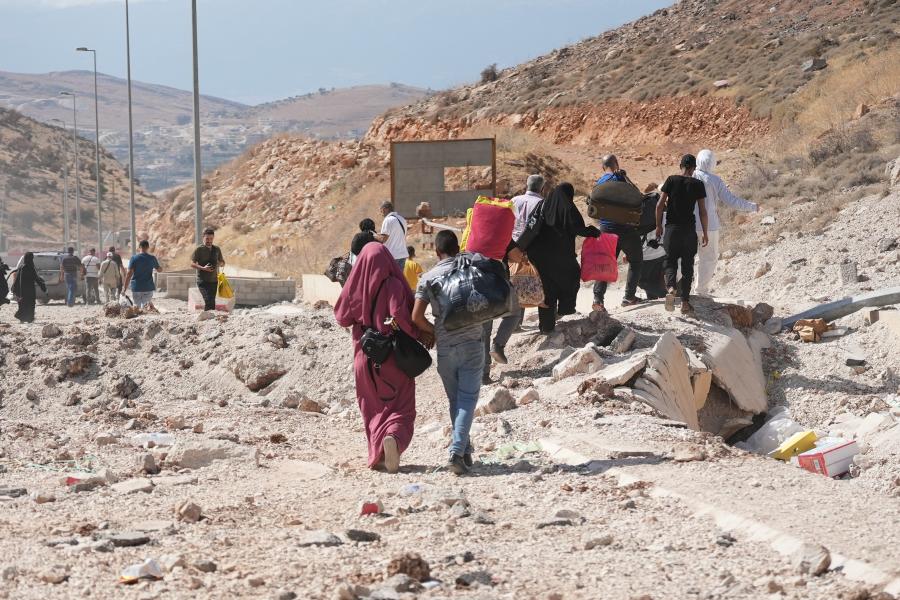Population figures | 2021 - 2025
2025 situation overview
The crisis in the Syrian Arab Republic is extending into its fourteenth year – with more people than ever sliding into deeper poverty and 16.7 million people in need of humanitarian assistance and protection. The Syria situation remains one of the largest displacement crises in the world, with a 2025 projection of 7.2 million internally displaced people (IDPs), and 6.2 million refugees, primarily hosted in the neighbouring countries of Egypt, Iraq, Jordan, Lebanon and Türkiye. UNHCR activities to assist forcibly displaced populations will include legal assistance, cash, provision of core relief items, and a range of protection services.
The outlook for 2025 and the situation of Syrian refugees in hosting countries is deeply concerning, due to great uncertainty around a peaceful solution to the crisis and growing conflicts in the region, coupled with limited funding and decreasing humanitarian and resilience support. Lack of employment and livelihood opportunities remain among the biggest challenges refugees face in their daily lives. Restrictive host country practices and policies have created a more adverse protection environment for Syrian refugees and deepened social tensions. Maintaining assistance to Syrian refugees in host countries in the region will remain of paramount importance, given that many refugees are likely to remain there in the medium term.
Spontaneous returns to Syria are expected to continue throughout 2025. In the first eight months of 2024, UNHCR verified over the return of over 34,000 Syrian refugees, although the actual figure may be significantly higher. The Lebanon crisis and subsequent influx into Syria in late September 2024 created a very dynamic situation, with an estimated 320,000 Syrian refugees returning to Syria under adverse circumstances as of 28 October 2024. Given the fluidity of the situation, it remains to be seen how many of those Syrian refugee returnees may remain in Syria, or wish to return to Lebanon, or move onward to other destinations.
In UNHCR’s ninth return perceptions and intentions survey (RPIS) among Syrian refugees in Egypt, Iraq, Jordan and Lebanon, which was published in mid-2024 (prior to the escalation of the conflict in Lebanon), a majority (57%) indicated they hoped to return to Syria one day and more than one third (37%) hoped to return in the next five years, reflecting an increase in the medium-term aspiration to return compared with the last survey conducted in 2023 (25%).
In line with previous rounds of surveys, less than 2% intended to return in the next 12 months. Refugees’ decision to return one day is grounded on a variety of considerations.
Concerns about safety and security inside Syria remain the key obstacle to return, while a lack of livelihoods is an increasingly important factor influencing refugees' decision-making.
Humanitarian needs inside Syria will persist. A primary focus for UNHCR in 2025 will be to strengthen humanitarian early recovery and resilience of communities through an area-based approach, which could also help to ensure the sustainability of returns and reintegration of Syrians. UNHCR will maintain emergency preparedness and response capacity, including for any continuing influx of Syrians from Lebanon, and will enhance protection for refugees in Syria and their inclusion into services and assistance provided by other actors.
Syrian refugees represent the refugee population with the highest global resettlement needs; close to 933,000 Syrians are projected to be in need of resettlement. Resettlement needs are greatest in Lebanon (prior to the escalation of conflict in September 2024), marked by a notable increase of 200,000 people from 2024 due to growing economic challenges and greater protection risks such as child labour, exploitation and deportation.
In 2025, UNHCR will continue to co-lead with UNDP the Regional Refugee and Resilience Plan (3RP) in response to the Syria crisis, coordinating the work of some 250 partners in support of national efforts in Egypt, Jordan, Lebanon, and Türkiye. The 3RP will remain a critical mechanism for addressing the complex needs of both refugees and host communities, serving as a bridge, linking immediate humanitarian needs with long-term national strategies aimed at fostering inclusive growth and sustainable development. Some 17.1 million people are estimated to be in need, and 11.9 million people will be targeted to receive aid in Türkiye, Lebanon, Jordan and Egypt with financial requirements of around $5 billion. Refugees returning to Syria in adverse circumstances will also be included. In a landscape marked by escalating needs, the plan emphasizes resilience-building, supporting national institutions, and ensuring that nobody is left behind.
As of 19 November 2024, UNHCR is responding to the significant escalation in hostilities in Lebanon, which has displaced more than 880,000 people within Lebanon and 550,000 across the border into the Syrian Arab Republic. People are still on the move. UNHCR is delivering vital protection services, cash assistance, safe shelter, and other essential support to people displaced by the conflict. The emergency response is not reflected in UNHCR’s 2025 budget, which was prepared prior.
*Figures are subject to change
Financial overview
Former Syrian refugee brings healing and recovery to trauma survivors
By Kristy Siegfried in Şanlıurfa, Türkiye
Jin Davod’s first thought on being jolted out of her sleep before dawn on 6 February, 2023, was that a bomb, like the ones that had narrowly missed her and her family in Syria nine years earlier, was about to fall on their apartment building in Şanlıurfa, southern Türkiye. Within seconds, she realized it was not a bomb but an earthquake and that she, her parents and three younger siblings needed to get out of the building as quickly as possible.
Read the story












